Introduction
Fish contributes approximately 16% of all animal protein and occupies a significant contribution in ameliorating the amino acids, fatty acids, lipid, soluble vitamins and micronutrients requirement of daily life throughout the world.1, 2 One of the most abundant freshwater fish species in the world is Silver carp (Hypophthalmichthys molitrix) which is distinguished by its nutritional values, wide availability, low cost of aquaculture production and high feed efficiency ratio.3 Moreover, it has been categorized as the second highest of all freshwater species with a production of 4,354,638 tons in 2015 worldwide aquaculture.4 The biochemical composition of silver carp is comparatively higher, and the protein, fat and moisture contents were found as 18.2 g, 3.0 g and 77.7 g respectively/100g of fish.5 However, the rapid quality deterioration soon after Post-mortem of fish makes them enormously putrefactive, mostly occurs for the presence of higher percent of unsaturated fatty acids, high moisture levels, rich nutrient content and microbial growth.6-7 Therefore, it is an urgent necessity to develop additional applicable treatment to extend shelf-life and reinforce the overall acceptability of fish. In this regard, organic acids such as acetic acid and ascorbic acid were used to retard the microbial growth while extending the shelf-life attributes of fish fillets during 9 days of refrigerated temperature (40C) storage period. Organic acids such as acetic acid and ascorbic acid have been found to have robust antimicrobial properties which are the precursor of the shelf life extension of fish.8, 10 Investigating the determination of the antimicrobial activities of acetic acid and ascorbic acid against four Shigella species reported that both acids exhibited the greatest antimicrobial activity in the paper disk diffusion experiment.8 Combine effects of organic acids such as ascorbic acid with lactic acids in food models also exhibited antimicrobial effects against Escherichia coli O157:H7,9 result showed that application of 0.2 or 0.4% ascorbic acid in along with 0.2% lactic acid may have potentiality as preservative to inhibit the growth of E. coliO157:H7 in food stuffs.9 Another study found that ascorbic acid extended shelf life of frozen fillets of Acipenser persicus during frozen storage.10 Alongside nutritional values of silver carp it has several other commercial and innovative uses such as Gelatin from silver carp fish could be effective in active packaging which is widely used in the production of edible films with perfect film forming ability as well as gas barrier property.11 However, reports on the application of organic acids on Hypophthalmichthys molitrix are still scant. Therefore, our goal of this study was to develop best treatment ways using organic acids such as acetic acid and ascorbic acid alone or in combination to extend the shelf life during 9 days of refrigerated temperature (40C) storage period while facilitating the efficient utilization of silver carp fish species.
Materials and Methods
This research investigation was conducted at the laboratory of food processing technology, Jiangnan University, Wuxi, China.
Samples and Treatment Formulation
Good quality silver carp (Hypophthalmichthys molitrix) fishes were obtained from supermarket of Wuxi, Jiangsu province of China and immediately transferred to the laboratory of food processing technology, Jiangnan University, Wuxi, China. The fresh fishes were stunned, scaled, gutted, sectioned, filleted and washed with sterile water. Then the fillets were divided into 4 groups and coded as T0, T1, T2, and T3. One group of fish fillets were kept untreated during the storage period and coded as T0. Acetic acid and ascorbic acid were applied in both separately and combined. Different combination such as 1% acetic acid and 2% ascorbic acid solutions were prepared using distilled water (v/v). The T1 group involved the action of 1% acetic acid, T2 group involved the action of 2% ascorbic acid and the T3 group involved 1% acetic acid followed by 2% ascorbic acid treatment. Prior exposing to treatments sensory scores for texture, color, odor, total viable bacterial count, pH and peroxide values were determined initially. All the samples were kept in refrigerator at 4ºC and every 3 days interval, random sample were taken out for analysis to determine sensory scores and other parameters until the fish fillets get spoilt.
Sensory Evaluation
At an interval of 3 days the fish fillets were taken out from refrigerated storage and presented to the expert panelist to investigate the sensorial quality parameters in case of untreated and treated raw silver carp fish fillets. Five expert panels were used to evaluate the sensory scores. The evaluation of sensory analysis was based on a five-point-scale: color (5, no discoloration; 1, extreme discoloration); odor (5, extremely desirable; 1, extremely unacceptable); texture (5, firm; 1, very soft); and overall quality (5, extremely desirable; 1, extremely unacceptable) of the samples. In addition, Rejection was claimed when the sensory score was below 4.0 for ‘sensorial attributes’ observation.12
pH Determination
The pH of fish samples was determined by homogenizing 10g of each sample in 100 ml distilled water prior and after that treatment was done at 3 days interval. About 30s the samples were homogenized in 100 ml of distilled water and pH was noted by setting the pH electrode in samples.13
Total Viable Count (TVC) Determination
Total Viable Count (TVC) is a quantitative method of enumerating microorganisms and provides a quantitative estimate of the concentration of microorganisms such as bacteria, yeast or mould spores in a sample. TVC were analyzed because this method shows a decent figure on how many colony forming units are present in the sample being analyzed to represent the total number of possible microbial growth.14-15 Fish samples (10g) were aseptically homogenized for 1 min in 90 ml of sterilized 85% NaCl saline using a stomacher Lab Blender (China). From this homogenized solution dilutions were made (10-2, 10-3, 10-4, 10-5, and 10-6) in 85% NaCl solution and that were used for microbiological analysis for fish samples at each of the 3days time intervals during storage in refrigeration. Total viable counts (TVC) were determined in plate count agar followed by spread plate method14 by inoculating 0.1 ml of the homogenate sample, at selected dilutions, onto duplicate sterile plates of pre poured and dried Standard Method Agar using the surface spread technique, and after that the plates were incubated for 48 h at 35°C.15
Oxidative Stability Determination
The oxidative stability of the untreated and treated fish samples was determined by Peroxide Value. Peroxide values of sample were determined by following the procedure described.16 Sample (5g) was heated in a water bath for 3 min at 60 °C then mixing through agitation in order to dissolve fat and then homogenization done by addition of 30 ml of acetic acid-chloroform solution (3:2 v/v). After completing filtration saturated potassium iodide solution was added in the filtrate 0.5 mL before transferring into a burette. The sample was titrated against a standard solution of sodium thiosulfate (25 g/L) using starch solution. Starch solution was used as an indicator. The peroxide value was calculated and expressed in milli-equivalents peroxides per kg of the samples by following equation (i).
Peroxide value (PV) = (S×N) / W × 1000 … (i)
Where,
S = Titration volume in ml
N = Normality of the sodium thiosulfate solution
W = Weight of sample in kg
Statistical Analysis
The collected data were analyzed by using the SPSS (version: 16.0) software. Three replications of the analysis were done and measurements of all parameters. Mean values for all parameters were calculated and compared by analysis of variance using SPSS. Experiments were done in triplicate (n=3) and a completely randomized design (CRD) was used.
Results and Discussion
Sensory Assessment
The sensory characteristics in each group were monitored over 9day’s period at an interval of 3 days. Sensory evaluation of food is one of the most crucial statistical tools used to identify the exact quality as well as consumer acceptability of a particular food or food product. The sensory attributes have significant effects on the treated silver carp fish fillets and have better sensory characteristics as compared to untreated fish samples. Texture, color and odor are determined critically since they are the obvious perception of eye perceived by the consumer and are the main criteria for consumer to evaluate a product. The results reveal that fish fillets treated with 1% acetic acid followed by 2% ascorbic acid significantly retain the texture, color, odor and overall acceptability during the 9 days period as perceived by panel of judges as compared to untreated and other treated fish samples.
Texture
The texture scores in different time in interval days are represented in figure 1. Texture scores of the treated and untreated fish was investigated and evaluated by hand feels at an interval of 3 days. Initially, the fish showed firm texture irrespective of treatment applied to the fish fillets and remained fresh up to 3 days. After 3 days the T0 (untreated), fish started to lose firm and freshness and became soft, after 6 days T1 (1% acetic acid treated) and T2 (2% ascorbic acid treated) samples became soft except the fish treated with T3 (1% acetic acid followed by 2% ascorbic acid). This indicates that acetic or ascorbic acid alone cannot extend shelf life up to 6 days. Texture sensory score was considered acceptable range when the score was ≥4 and rejection or low quality was claimed when the score was <4 on a scale of 5 as described.12 From the figure 1 it is observed that fish treated with T3 extends the shelf life of fish up to 9 days thereby indicates that acetic acid followed by 2% ascorbic acid treatment inhibit or reduce the growth and activity of microorganisms. The decrease in texture sensory scores was observed in all of the samples treated. However, the lowest decrease was found in the sample T3 treated (1% acetic acid followed by 2% ascorbic acid). The soft texture occurred by the texture quality deterioration can be attributed by various microorganisms mostly from bacterial species which affect the fish protein structure.17, 27
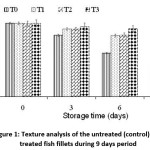 |
Figure 1: Texture analysis of the untreated (control) and treated fish fillets during 9 days period Click here to View figure |
It has been reported that microbial growth is responsible for slime formation, structural components degradation, off odors and appearance changes in food components.27 Few microorganisms such as Pseudomonas, Shewanella putrefaciens, and Aeromonas under aerobic condition have been found responsible for limiting the shelf-life of fish by making the texture of the fish susceptible and fragile due to their action on tissues of the fish components consequently disrupting the cells and producing toxins additionally.17, 27
Table 1: Sensory scores of the untreated and treated fish fillets
| Sensoryparameters | Treatment | Day Interval | |||
| 0 | 3 | 6 | 9 | ||
| Texture | T0 | 4.92±0.06 | 4.11±0.09 | 2.92±0.16 | 2.18±0.23 |
| T1 | 4.91±0.07 | 4.53±0.08 | 4.09±0.10 | 2.95±0.24 | |
| T2 | 4.90±0.04 | 4.54±0.10 | 4.13±0.14 | 3.01±0.20 | |
| T3 | 4.91±0.04 | 4.69±0.10 | 4.55±0.07 | 4.12±0.07 | |
| Color | T0 | 4.9±0.06 | 4.06±0.08 | 2.95±0.10 | 2.22±0.08 |
| T1 | 4.88±0.06 | 4.46±0.09 | 4.09±0.09 | 3.03±0.07 | |
| T2 | 4.87±0.04 | 4.53±0.10 | 4.07±0.09 | 2.99±0.09 | |
| T3 | 4.88±0.07 | 4.72±0.05 | 4.47±0.16 | 4.14±0.09 | |
| Odor | T0 | 4.89±0.06 | 4.08±0.08 | 2.92±0.14 | 2.21±0.08 |
| T1 | 4.85±0.09 | 4.47±0.09 | 4.09±0.09 | 3.06±0.16 | |
| T2 | 4.88±0.04 | 4.54±0.10 | 4.12±0.13 | 3±0.09 | |
| T3 | 4.87±0.07 | 4.73±0.06 | 4.56±0.07 | 4.14±0.09 | |
| Overall acceptability | T0 | 4.92±0.06 | 4.09±0.09 | 2.94±0.13 | 2.21±0.23 |
| T1 | 4.89±0.05 | 4.51±0.06 | 4.08±0.09 | 2.94±0.17 | |
| T2 | 4.88±0.04 | 4.54±0.10 | 4.13±0.14 | 2.97±0.12 | |
| T3 | 4.89±0.05 | 4.73±0.06 | 4.56±0.07 | 4.08±0.08 | |
Values are mean ± standard deviation of determinations (n=3)
Table 2: pH, Peroxide values and microbial counts of the untreated and treated fish fillets
| Test Parameters | Treatment | Day interval | |||
| 0 | 3 | 6 | 9 | ||
| pH | T0 | 5.96±0.02 | 6.21±0.02 | 6.96±0.01 | 7.5±0.02 |
| T1 | 5.05±0.02 | 5.65±0.01 | 6.30±0.02 | 7.09±0.03 | |
| T2 | 4.84±0.01 | 5.35±0.02 | 6.10±0.02 | 6.96±0.02 | |
| T3 | 4.44±0.02 | 5.06±0.02 | 5.85±0.01 | 5.28±0.02 | |
| Peroxidevalues | T0 | 0.06±0.01 | 0.89±0.01 | 1.21±0.02 | 1.96±0.01 |
| T1 | 0.03±0.01 | 0.51±0.01 | 0.91±0.01 | 1.69±0.01 | |
| T2 | 0.02±0.01 | 0.39±0.02 | 0.79±0.01 | 1.51±0.04 | |
| T3 | 0.02±0.01 | 0.35±0.01 | 0.51±0.01 | 0.81±0.01 | |
| MicrobialCountsTVC ( log10 CFU/g) | T0 | 4.12±0.01 | 6.81±0.03 | 9.21±0.08 | 12.03±0.05 |
| T1 | 3.96±0.02 | 5.51±0.03 | 6.91±0.02 | 9.09±0.02 | |
| T2 | 3.88±0.02 | 5.01±0.02 | 6.78±0.03 | 8.38±0.02 | |
| T3 | 3.83±0.02 | 4.01±0.05 | 5.01±0.04 | 6.89±0.01 | |
Values are mean ± standard deviation of determinations (n=3)
Color
The color scores in different time and interval days are represented in figure 2. The color of the treated and untreated fish was observed and evaluated at an interval of 3 days during 9 days of refrigerated temperature (40C) storage period. T0 (untreated) and T2 treated fish showed more deterioration in color attributes than T1 and T3 treated fish fillet samples. However, the color was observed by the perception of the expert panel used to evaluate the sensorial attributes. After 3 days the samples were observed and perceived for the color attributes. However, the deterioration in color attributes was observed greater after 6 days of storage period. Sample treated with T0 fish became pale red color, on the other hand sample with T1 and T2 treated showed whitish brown color after 6 days. As for the T3 treated samples at the end of 9 days refrigerated storage period, the samples remained the same with slight deterioration in color attributes from fresh color to slightly whitish color. The external surface of fish is covered by muscle tissue and some parts are covered by connective or adipose tissue. Fish meat tissue has a red color and its chemical composition differs from that of the other two tissues. The red color of fish is due to the presence of pigments. The color changes of the surface of carcasses after decontamination by acetic acid and ascorbic acid can be explained by the denaturation of surface layers followed by oxidation of fish pigments and to changes of protein hydration, due to reduction of pH after ascorbic acid treatment.18 Study on the color changes in quality of food products determined that the changes in color quality attributes are due the attributes downcast of protein, fat and other important bio-molecules due to water activity and microbial invasion.18 However, regardless of the formulation of different treatment the color attributes were found to be decreasing as the storage days passed. In our study we found that the combined T3 treatment with acetic acid and ascorbic acid mostly retained the color attributes as compared to other samples that kept untreated and treated separately (figure 2).
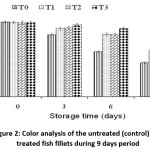 |
Figure 2: Color analysis of the untreated (control) and treated fish fillets during 9 days period Click here to View figure |
Odor
The odor of the treated and untreated fish represented in figure 3. Sensory scores for odor was observed and evaluated and the data was recorded at an interval of 3 days. The entire treated and untreated sample represents naturally fishy flavor just after treatment. After 6 days all three samples including T0, T1 and T2 treated fish smell slightly fermented with bad odor observed by the perception of the panelist working on sensorial evaluation. Noticeably, the sample treated with T3 treated retained the natural odor up to 9 days of investigation. However, undesirable odor attributes were observed in the T0, T1 and T2 samples at the end of 9 days refrigerated storage period (figure 3). The bad odor is due to microbial invasion, rancidity of fat and putrefaction of protein. Microbial invasion starts soon after postmortem and Spoil the natural odor of fish rapidly.20 This bad odor can be attributed due to rancidity of fat and putrefaction of protein. In addition, studies observed that microbial growth and metabolism are a major cause of fish spoilage which produces different unpleasant compounds which later render the development of off-flavors.19-20
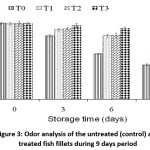 |
Figure 3: Odor analysis of the untreated (control) and treated fish fillets during 9 days period Click here to View figure |
Microbial Studies
Microbial counts (TVC) of the treated and untreated fish samples during 9 days refrigerated storage period are presented in Figure 4. The four samples were stored in refrigerator (4ºC) after the application of different treatments and microbial study was evaluated over the storage period of 9 days at an interval of 3 days according to total viable count method. Prior to the treatments the microbial count of fresh fish was also evaluated and the comparison of the microbial count of sample with T1, T2 and T3 treatment with the microbial count of fresh fish also evaluated. Therefore, the efficaciousness of acetic acid, ascorbic acid, and their combined effect for decontaminating fish were revealed. Acetic acid and ascorbic acid both are both regarded as antimicrobial agents for their decontaminating activity.8-9 Their application intending on surface decontamination of fish reduced the bacterial load on fish and also inhibited the growth of bacteria.9 When the combined treatment was applied it worked more efficaciously. Acetic acid increased the fish surface temperature and ascorbic acid reduced the pH of fish which is regarded as an adverse condition for bacterial growth.8, 9 Our investigation observed that the combined treatment was more effective than the single acetic acid and ascorbic acid treatment. Total Viable Counts (TVC) for untreated and treated samples were found in the following order- (T0>T1>T2>T3) and (T0>T1>T2>T3) for 0th day and 9th day respectively. At 0th day, the TVC were found (4.12, 3.96, 3.88 and 3.83) log 10 cfu/g for T0, T1, T2 and T3 respectively. However, at the end of 9 days storage the microbial growth in the samples T3 treated were found to have the lowest growth elevation. At 9th day the TVC were found in the following order– (12.03, 9.09, 8.38 and 6.89) log 10 cfu/g for T0, T1, T2 and T3 respectively. At 0th day, all of the samples were in acceptable limit according to the recommended guidelines.28, 29
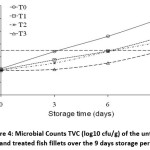 |
Figure 4: Microbial Counts TVC (log10 cfu/g) of the untreated and treated fish fillets over the 9 days storage period Click here to View figure |
However, at end of 9 days storage period T0, T1 and T3 treated sample’s total viable counts went beyond the recommended acceptable limit but the T3 treated samples mostly retained its microbial growth and the growth was below the recommended limit.28, 29 Therefore, it is apparent that different decontaminating treatments slowed down the bacterial growth in fish but the sample treated with combination of acetic acid and ascorbic acid showed the lowest microbial growth and longer shelf life during the 9 days refrigerated storage period.
pH
pH value of food is considered an important attribute that is affecting its quality and shelf stability by regulating many functions and reactions. The data explicated in Figure 5 showed significant variations in pH of fish sample as a result of treatments. The pH of the T0 (untreated), T1, T2 and T3 treated samples were found 5.56, 5.05, 4.48 and 4.44 respectively at 0 day. We found that the sample treated with 1% acetic acid followed by 2% ascorbic acid scored lowest pH value and apparently this happens due to their combined effects up to 9 days at 3 days interval. There was a reduction in pH of all four samples during storage. Amongst the treatments, pH of the sample treated with T3 (1% acetic acid followed by 2% ascorbic acid) was ranked lowest which was advantageous and efficacious to inhibit the microbial growth and to keep it fresh for longer time as it creates unfavorable condition to microbial growth. Although, the treatment with acetic acid and ascorbic acid causes reduction in pH but this did not affect the sensorial evaluation.
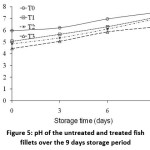 |
Figure 5: pH of the untreated and treated fish fillets over the 9 days storage period Click here to View figure |
A similar investigation was conducted (Fan, 2013) who reported that an increase in pH of silver carp fish fillets associated with volatile bases production due to the degradation of protein to ammonia and trimethylamine by microbial or endogenous enzymes.21
Oxidative stability and overall acceptability
Peroxide value (PV) is the primary measurement used to indicate the concentration of primary lipid oxidation products. The values of PV and overall acceptability are documented in figure 6 (A) and 6(B) respectively. Highest PV values were observed in T0 (untreated) sample and the lowest PV values were observed in T3 treated sample. The PV values for T0, T1, T2 and T3 treated fish at 0 day were found 0.06, 0.03, 0.02 and 0.02 meq/kg respectively and there was no significant increase in PV of sample treated with T3 treatment. After the 9 days observation the highest elevation of PV is recorded in sample T0 (untreated) and the lowest PV is recorded in sample treated with T3 treatment. The PV increase was slower in all the sample including T1,T2 and T3 than the T0 (untreated) samples during the storage although the values for all samples were so lower than 10 meq/ kg of lipid, regarded generally as the acceptable level.22 A distinct elevation of PV observed in the untreated group and at the end of 9 days treatment the PV scores were slightly increases for T0, T1, T2 and T3 which was 1.96, 1.69, 1.51 and 0.81 meq/kg respectively. Therefore, the result indicated that the combined treatment has effected in retarding the production of primary lipid oxidation products in the silver carp fillets. Therefore, it is obvious that the combined acetic acid and ascorbic acid are significantly workable in retarding the oxidative degradation.
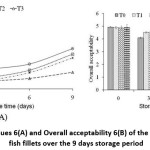 |
Figure 6: Peroxide Values 6(A) and Overall acceptability 6(B) of the untreated and treated fish fillets over the 9 days storage period Click here to View figure |
As for the overall acceptability T0 treated sample showed the highest (4.92) on 0 days and the sample treated with T2 showed the lowest (4.88) after 9 days treatment on limit of 7. There was no significant reduction in sample treated with T3 at 0 day but the other entire samples treated with T0, T1 and T2 significantly showed lower overall acceptability at 3 days interval. After the 9 days treatment we found the overall acceptability still higher in sample treated with T3 and that was 4.08, 2.97, 2.94 and 2.21 for T3, T2, T1 and untreated fish respectively.
This study clearly revealed that fish samples treated with combination of acetic acid and ascorbic acid mostly retain the sensory attributes including texture, color and flavor and other quality attributes. The lowest results in PV and microbial loads in T3 treated samples also beckon that the application of acetic acid and ascorbic acid in fish preservation are efficacious, therefore, the application of organic acids such as acetic and ascorbic acid can be a very easy handling, cheap and productive in retarding oxidative degradation and also reducing microbial invasion mostly occurs by the activity of different gram positive and gram negative bacteria. A very crucial chemical reaction in fish muscles which is namely lipid oxidation reactions; can lead to the development of rancidity, loss of nutritional value from the destruction of vitamins (A, D and E) and essential fatty acids and the possible formation of toxic compounds and color.23 Alongside, Oxidation of lipids may change and affect the color, aroma, texture and even the nutritive value of the food.23 Fats in fish are highly prehensile to oxidation during storage and is one of the most critical reasons of spoilage mostly occurs in fish and fish products which rendered by formation of poisonous compounds and gradual reduction of nutrition value.24 Hydroperoxides are reported as primary products of lipid oxidation which has been alleged for their reaction between these products with other molecules leading to development of “off color” and “off odor” in fish and fish products.25 In our investigation we found that, there were significant differences between the oxidative stability of the T1, T2, and T3 with T0 (untreated) and the highly elevated initial PV of the untreated sample suggests that the onset of lipid oxidation in this system already occurring during the storage period. Therefore, that the treated fish generally has lower peroxide value than untreated fish and that treated fish will be more stable than the untreated fish. For the microbial loads we found that Fish sample treated with T3 (1% acetic acid followed by 2% ascorbic acid) showed the lowest initial microbial count (6.89 log10 CFU/g). Their combined treatment was mostly fertile that both acetic acid and ascorbic acid showed decontaminating efficacy. Our findings also resemble with another study which suggest that ascorbic acid in combination with select organic acids such as propionic acid has potential antimicrobial effects in minced beef preservation and in combination with lactic acid against Listeria monocytogenes.26 These studies clearly showed that the application of ascorbic acid and acetic and combined effect may have the potential antimicrobial effect against different detrimental microorganism which is responsible for the quick deterioration of fish; therefore leading to a significant extension of shelf life. The pH of the samples also played an instructive role in retarding the shelf life. We found that pH of the sample treated with T3 was ranked lowest which was advantageous and efficacious to inhibit the microbial growth and to keep it fresh for longer time as it creates adverse condition to microbial growth. Besides21 who reported an increase in pH of silver carp fish fillets associated with the degradation of protein by microbial or endogenous enzymes. Remarkably the sample with T3 treated showed lowest pH and we strongly suggest that this combined effect possesses potentiality to retard the oxidative damage and microbial spoilage as well. We also recommend that good hygiene from onset of fishing to handling of fish caught will reduce the onset of spoilage which could be a leading factor in peroxide production and oxidation of lipid in fish. Currently, the application of organic acids in food preservation is now becoming popular because of their cheapness, easy handling and significant workability regardless of small application. The successful commercial application of this treatment inhibiting spoilage and extending shelf-life of fish and fish products is associated with a number of interrelated factors, such as development of different method, food/product characteristics consumer concerns about preservation additives in such products and favorable consumer perception. So considering the significant reduction in microbial loads, retention in sensory attributes and retardation in oxidative spoilage it can be sum up that the combined effect of acetic acid and ascorbic acid have robust protective effect against quality spoilage invasion.
Conclusion
This 9 days investigation on the shelf life of silver carp fish fillets at refrigerated temperature (40C) reveals that the fish fillets treated with the combination of acetic acid and ascorbic acid treatment has shown the best quality preservation and overall shelf life retention in comparison to other treatment. Therefore, we suggest that keeping quality as well as efficacy by combined acetic acid and ascorbic acid spray was proved to be satisfactory and acceptable of microbiological, economical, easier, extending shelf life and approach perspective. We also recommend that further research is needed to study on hygienic handling of fish at slaughterhouse and selling center for more insights to increase shelf life of fish and retaining its quality.
Acknowledgements
This research work was financially supported by the earmarked fund for China Agriculture Research System (CARS-45-26) Jiangsu Project for Fisheries (Y 2017-30).
Conflicts of Interest
All authors have no conflicts of interest to declare.
References
- (Food and Agriculture Organization of the United Nations, 2010). The state of world fisheries and aquaculture. Rome, Italy, pp 1-38. http://www.fao.org/3/a-i1820e.pdf
- Medina, I., Gallardo, J.M. and Aubourg, S.P. 2009. Quality preservation in chilled and frozen fish products by employment of slurry ice and natural antioxidants. International journal of food science & technology. 2009;44(8): 1467-1479.
CrossRef - Valipour Kootenaie, F., Ariaii, P., KhademiShurmasti, D. and Nemati, M. Effect of chitosan edible coating enriched with eucalyptus essential oil and α‐tocopherol on silver carp fillets quality during refrigerated storage. Journal of food safety. 2017; 37(1).
CrossRef - Food and Agriculture Organization of the United Nations (FAO). 2016. FAO-yearbook of fishery statistics: Aquaculture production. Rome, Italy. http://www.fao.org/fishery/publications/yearbooks/en
- Bogard, J.R., Thilsted, S.H., Marks, G.C., Wahab, M.A., Hossain, M.A., Jakobsen, J. and Stangoulis, J. Nutrient composition of important fish species in Bangladesh and potential contribution to recommended nutrient intakes. Journal of Food Composition and Analysis. 2015;42:120-133.
CrossRef - Song, Y., Luo, Y., You, J., Shen, H. and Hu, S. Biochemical, sensory and microbiological attributes of bream (Megalobramaamblycephala) during partial freezing and chilled storage. Journal of the Science of Food and Agriculture. 2012;92(1):197-202.
CrossRef - Fan, H., Luo, Y., Yin, X., Bao, Y. and Feng, L. Biogenic amine and quality changes in lightly salt-and sugar-salted black carp (Mylopharyngodonpiceus) fillets stored at 4°C. Food Chemistry.2014; 159:20-28.
CrossRef - In, Y.W., Kim, J.J., Kim, H.J. and Oh, S.W. Antimicrobial Activities of Acetic Acid, Citric Acid and Lactic Acid against Shigella Journal of Food Safety.2013;33(1):79-85.
CrossRef - Tajkarimi, M. and Ibrahim, S.A. Antimicrobial activity of ascorbic acid alone or in combination with lactic acid on Escherichia coli O157: H7 in laboratory medium and carrot juice. Food Control.2011;22(6):801-804.
CrossRef - Rostamzad, H., Shabanpour, B., Kashaninejad, M. and Shabani, A. Inhibitory impacts of natural antioxidants (ascorbic and citric acid) and vacuum packaging on lipid oxidation in frozen Persian sturgeon fillets. Iranian Journal of Fisheries Sciences.2010;9(2):279-292.
- Wu, J., Chen, S., Ge, S., Miao, J., Li, J. and Zhang, Q. Preparation, properties and antioxidant activity of an active film from silver carp (Hypophthalmichthys molitrix) skin gelatin incorporated with green tea extract. Food Hydrocolloids.2013;32(1):42-51.
CrossRef - Arfat, Y.A., Benjakul, S., Vongkamjan, K., Sumpavapol, P. and Yarnpakdee, S. Shelf-life extension of refrigerated sea bass slices wrapped with fish protein isolate/fish skin gelatin-ZnO nanocomposite film incorporated with basil leaf essential oil. Journal of food science and technology.2015;52(10):6182-6193.
CrossRef - Rossini, K., Norena, C.P., Cladera-Olivera, F. and Brandelli, A. Casein peptides with inhibitory activity on lipid oxidation in beef homogenates and mechanically deboned poultry meat. LWT-food Science and Technology. 2009; 42(4):862-867.
CrossRef - Naveena, B.M., Sen, A.R., Vaithiyanathan, S., Babji, Y. and Kondaiah, N. Comparative efficacy of pomegranate juice, pomegranate rind powder extract and BHT as antioxidants in cooked chicken patties. Meat Science. 2008; 80(4): 1304-1308.
CrossRef - Tarkhasi A. Effect of Edible Coating Containing Pomegranate Peel Extract on Quality and Shelf Life of Silver Carp (Hypophthalmichthys molitrix) Fillet during Refrigerated Storage. J Food Ind Microbiol. 2016.
CrossRef - Shon, J. and Chin, K.B. Effect of whey protein coating on quality attributes of low‐fat, aerobically packaged sausage during refrigerated storage. Journal of food science. 2008;73(6):469-475.
CrossRef - Sankar, C.R., Lalitha, K.V., Jose, L., Manju, S. and Gopal, T.K.S., 2008. Effect of packaging atmosphere on the microbial attributes of pearlspot (Etroplussuratensis Bloch) stored at 0–2C. Food microbiology. 2008; 25(3): 518-528.
CrossRef - Masniyom, P. Deterioration and shelf-life extension of fish and fishery products by modified atmosphere packaging. Songklanakarin Journal of Science & Technology, 2011;33(2).
- Dalgaard, P., Madsen, H.L., Samieian, N. and Emborg, J.. Biogenic amine formation and microbial spoilage in chilled garfish (Belone belonebelone)–effect of modified atmosphere packaging and previous frozen storage. Journal of Applied Microbiology. 2006; 101(1):80-95.
CrossRef - Emborg, J., Laursen, B.G. and Dalgaard, P. Significant histamine formation in tuna (Thunnusalbacares) at 2 C—effect of vacuum and modified atmosphere-packaging on psychrotolerant bacteria. International Journal of Food Microbiology. 2005; 101(3):263-279.
CrossRef - Fan, W., Sun, J., Chen, Y., Qiu, J., Zhang, Y. and Chi, Y. Effects of chitosan coating on quality and shelf life of silver carp during frozen storage. Food 2009; 115(1):66-70.
CrossRef - Jeon, Y.J., Kamil, J.Y. and Shahidi, F. Chitosan as an edible invisible film for quality preservation of herring and Atlantic cod. Journal of Agricultural and Food Chemistry.2002;50 (18):5167-5178.
CrossRef - Farajzadeh, F., Motamedzadegan, A., Shahidi, S.A. and Hamzeh, S. The effect of chitosan-gelatin coating on the quality of shrimp (Litopenaeusvannamei) under refrigerated condition. Food Control,2016:67:163-170.
CrossRef - Sahoo, J., Karwasra, R.K. and Hooda, S. Studies on alpha-tocopherol acetate as an antioxidant in chicken mince on its quality during refrigerated storage. JOURNAL OF FOOD SCIENCE AND TECHNOLOGY-MYSORE.2004:41(3):240-243.
- Lee, B.J., Hendricks, D.G. and Cornforth, D.P. Antioxidant effects of carnosine and phytic acid in a model beef system. Journal of Food Science.1998;63(3):394-398.
CrossRef - Giannuzzi, L. and Zaritzky, N.E. Effect of ascorbic acid in comparison to citric and lactic acid on Listeria monocytogenes inhibition at refrigeration temperatures. -Wiss. u.-Techno. 1996;29(3):278-285.
CrossRef - Russell, S. M., D. L. Fletcher, and N. A. Cox. Spoilage bacteria of fresh broiler chicken carcasses. Poultry Science. 74, no. 12 (1995): 2041-2047.
CrossRef - Australian/New Zealand standards methods for Food Microbiology. (1999): Guide to determine the equivalence of Food Microbiology nest method. AS/NZS 4659.
- Rindhe, S. N., P. N. Zanjad, V. K. Doifode, A. Siddique, and M. S. Mendhe. “Assessment of microbial contamination of chicken products sold in Parbhani city.” Veterinary World 1, no. 7 (2008): 208.

This work is licensed under a Creative Commons Attribution 4.0 International License.






